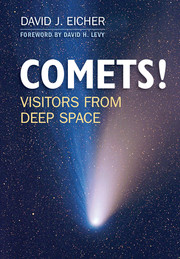Book contents
- Frontmatter
- Dedication
- Contents
- List of Figures
- List of Plates
- Foreword
- Preface
- Acknowledgments
- 1 Strange Lights in the Sky
- 2 Great Comets
- 3 What Are Comets?
- 4 Comets of the Modern Era
- 5 Comets in Human Culture
- 6 Where Comets Live
- 7 The Expanding Science of Comets
- 8 Observing Comets
- 9 Imaging Comets
- Glossary
- Bibliography
- Index
- Plate Section
3 - What Are Comets?
Published online by Cambridge University Press: 05 October 2013
- Frontmatter
- Dedication
- Contents
- List of Figures
- List of Plates
- Foreword
- Preface
- Acknowledgments
- 1 Strange Lights in the Sky
- 2 Great Comets
- 3 What Are Comets?
- 4 Comets of the Modern Era
- 5 Comets in Human Culture
- 6 Where Comets Live
- 7 The Expanding Science of Comets
- 8 Observing Comets
- 9 Imaging Comets
- Glossary
- Bibliography
- Index
- Plate Section
Summary
The universe is a dynamic, active, often violent place. Stars, planets, and galaxies undergo rapid change, constantly worked on by their environments. Seeing Earth, the Sun, or the Milky Way as it was long ago is just not possible. Comets, however, give astronomers a precious storehouse of ancient information. They are relatively pristine, ancient blocks of ice that allow us to peer back in time.
Astronomers’ knowledge of comets is still developing, but the knowledge base is vastly larger than it was a generation ago. Strangely, planetary scientists have gleaned much of what they know about comets without knowing precise numbers on some of their most basic physical properties. All we know about the shapes, sizes, and albedos (how reflective of sunlight the comet is) of the nuclei of comets has been gained from the small number of close visits to comets by spacecraft. In this way, only about two dozen comets are well known.
When astronomers observe comets from Earth, they face challenges like making assumptions about the object’s albedo, which they can then use to calculate a presumed size. Recent measurements of a small number of comets such as 9P/Tempel 1 with the Spitzer Space Telescope, in 2005, suggested a low albedo of about 4 percent for that comet. The Deep Impact mission measured the comet at 7.6 by 4.9 km, and the inferred mass for Tempel 1 is about 75 trillion kg, on the basis of a density of 0.62 g/cm3 calculated from data from Deep Impact , the spacecraft that encountered the comet. (By comparison, water has a density of 1 g/cm3.)
- Type
- Chapter
- Information
- COMETS!Visitors from Deep Space, pp. 47 - 70Publisher: Cambridge University PressPrint publication year: 2013



